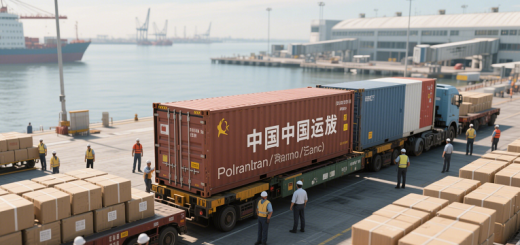Shipping Liquids & Powders from China: Safe, Compliant Consolidation for EU & US
Introduction
Shipping liquid or powder goods from China to Europe or North America? Navigating international regulations, customs scrutiny, and shipping restrictions can feel overwhelming—especially for non-hazardous materials. Whether you’re an ecommerce seller, expat, or shopper, this guide covers everything you need to know about compliant consolidation, packaging, and documentation to ensure your shipments arrive safely and hassle-free.
1. Why Liquids & Powders Require Extra Caution
Liquids and powders pose unique challenges in international shipping:
- Leakage Risk: Spills can damage other goods and lead to carrier fines.
- Customs Red Flags: Powders may be mistaken for illicit substances (e.g., drugs), triggering extra inspections.
- Labeling Requirements: Mislabeled packages risk rejection or seizure.
- Carrier Restrictions: Many logistics providers limit liquid/powder shipments due to safety concerns.
Key Compliance Areas:
- Proper categorization (non-hazardous vs. hazardous).
- Strict adherence to EU/US import rules.
- Professional packaging to prevent leaks or contamination.
2. Step 1: Confirm Your Goods Are Non-Hazardous
Before shipping, verify that your items are not classified as hazardous. Common non-hazardous examples include:
- Liquids: Food sauces, cosmetics, oils, alcoholic beverages (below flammable limits).
- Powders: Baby formula, protein powder, coffee, sugar, flour.
Critical Check: Obtain an MSDS (Material Safety Data Sheet) or product certification to confirm non-hazard status. If in doubt, consult a chemist or use the UN Number lookup tool.
3. Step 2: Choose a China Consolidation Service That Specializes in Liquids/Powders
Not all consolidators handle liquids and powders. Look for providers with:
- Experience: Ask about their track record with similar shipments.
- Compliance Team: Ensure they handle customs documentation and labeling.
- Packaging Services: Offer leak-proof solutions (e.g., vacuum sealing, double packaging).
- Transparent Policies: Clear rules about restricted items and insurance coverage.
Red Flags: Avoid consolidators who:
- Dismiss your concerns about leaks or customs.
- Lack clear policies on damaged/spilled goods.
- Charge hidden fees for “special handling.”
4. Step 3: Master Packaging Techniques
Proper packaging is the #1 defense against leaks, spills, and customs delays. Follow these best practices:
A. For Liquids
- Seal Bottles Tightly: Use leak-proof caps or add plastic film around lids.
- Double Bagging: Place bottles in resealable plastic bags (e.g., Ziploc) to catch spills.
- Shock Absorption: Wrap bottles in bubble wrap or foam padding.
- Upright Positioning: Use partitioned boxes to keep bottles upright.
- Outer Box Protection: Add “Fragile” labels and cushioning inside the shipping box.
B. For Powders
- Tape & Seal: Secure lids with plastic tape to prevent spillage.
- Vacuum Seal: Remove air from bags to minimize shifting during transit.
- Inner Containment: Place powder containers in plastic bags as a backup.
- Label Clearly: Mark contents (e.g., “Baby Formula,” “Coffee”) to avoid customs suspicion.
C. Universal Tips
- Avoid Glass Containers: Opt for plastic or aluminum-coated bottles.
- Test Seals: Shake packages gently before shipping to check for leaks.
- Use Moisture-Absorbing Packs: Prevent condensation in humid environments.
5. Step 4: Navigate Customs & Labeling Rules
EU and US customs have strict requirements for liquids and powders. Miss a detail, and your shipment could face delays or confiscation.
EU Customs Requirements
- Prohibited Liquids: Alcohol over 24% volume, perfumes (if mislabeled).
- Labeling: Include the following in both English and destination language:
- Content description (e.g., “Non-Alcoholic Beverage”).
- Weight/volume (in metric units).
- Country of origin.
- Documentation: Attach a commercial invoice declaring the nature of the goods.
US Customs Requirements
- FDA-Regulated Goods: Food, cosmetics, supplements must comply with FDA standards.
- Hazmat Rules: Even non-flammable liquids may need special labeling (e.g., “Oral Liquid”).
- Declaring Value: Under-declaring value can raise suspicion of tax evasion.
Must-Do’s:
- Add “Non-Hazardous” labels to deter excessive screening.
- Avoid ambiguous terms like “Gear” or “Accessories”—state exact product names.
- Use waterproof labels to prevent smudging.
6. Step 5: Ship with Approved Carriers
Some carriers ban liquids/powders entirely, while others require special arrangements. Here’s what to know:
Air Cargo Options
- DHL/FedEx/UPS: Permit non-hazardous liquids/powders but charge higher rates.
- China Post/EMS: Affordable but slower; stricter size/weight limits.
- Specialized Carriers: Companies like P2P Mail or Shippo offer consolidated shipping with liquid/powder expertise.
Sea Freight Alternatives
For large quantities, sea freight is cost-effective but slower. Ensure:
- Pallets are secured with straps and plastic wrap.
- Cases are labeled as “Top Load Only” if sensitive to pressure.
7. Cost-Saving Tips Without Sacrificing Safety
- Consolidate Shipments: Combine multiple liquid/powder items to reduce per-unit costs.
- Use Flat-Rate Boxes: Services like DHL’s “Small Business Box” offer discounted rates.
- Pre-Buy Packaging Supplies: Stock up on vacuum sealers, bubble wrap, and leak-proof bags in China to save.
- Avoid Peak Seasons: Rates surge during holidays; plan shipments accordingly.
8. Troubleshooting Common Issues
Q: My package was flagged at customs. What now?
- Contact your consolidator immediately for documentation support.
- Provide proof of purchase, MSDS sheets, and clear product descriptions.
Q: How do I prevent leaks during hot/cold weather?
- Insulate packages with reflective material or gel packs (for temperature control).
- Avoid shipping heat-sensitive liquids (e.g., chocolate syrup) in summer.
Q: Can I ship alcohol or perfume?
- Alcohol over 24% is restricted in the EU/US. Use specialized carriers or declare accurately.
9. Final Checklist for Compliant Shipments
- [ ] Confirm goods are non-hazardous (check MSDS/certifications).
- [ ] Partner with a consolidator experienced in liquids/powders.
- [ ] Use leak-proof packaging (double bags, vacuum sealing, etc.).
- [ ] Label clearly with content, value, and “Non-Hazardous” disclaimers.
- [ ] Declare accurate weights/volumes on customs forms.
- [ ] Track shipments via carrier tools to address issues proactively.
Conclusion
Shipping liquids and powders from China doesn’t have to be a headache. By choosing compliant consolidators, mastering packaging techniques, and navigating customs rules, you can safeguard your goods and avoid costly delays. Start by auditing your current process—and consider partnering with experts to simplify the journey!

